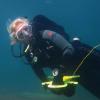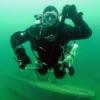
Why 80%??
#1

Posted 15 November 2004 - 09:29 AM
"I believe in Christianity as I believe that the sun has risen: not only because I see it, but because by it I see everything else." C. S. Lewis
#2

Posted 15 November 2004 - 10:26 AM
DSSW,
WWW™
#3

Posted 15 November 2004 - 10:42 AM
I know- guess I didn't phrase it correctly- Why would he be CARRYING 80% on the dive? I'm assuming that there is a depth that he could have switched to that mix for deco safely-what would that depth be?The higher the O2 percentage, the faster the decompression. Many divers decompress on 100% O2. The deco bottle is not a backup air source while at depth. Your backup air source would be in another cylinder.
"I believe in Christianity as I believe that the sun has risen: not only because I see it, but because by it I see everything else." C. S. Lewis
#4

Posted 15 November 2004 - 11:06 AM
You're nitrox certified. I'll let you figure your MOD for 80%.
As to why someone would carry their deco mix - there are advantages and disadvantages. Carrying the deco bottle at depth means you could breath the wrong mix at depth and drown while toxing. OTOH, leaving the deco bottle on the line means you won't have it for deco if you miss the upline.
DSSW,
WWW™
#5

Posted 15 November 2004 - 11:11 AM
The theory behind EAN80 is that if something happens to one's buoyancy on pure O2, they will be below 20 ft. (the 1.6 PO2 for pure O2) before they know it and some sea conditions cause issues with indicated depth. EAN80 vs. pure O2 buys these divers a ten ft. cushion on MOD to allow for these issues. The problem is that is really doesn't buy you any more accelerated deco than EAN50 picked up at 70 ft. I know this by experience.
The bottle of EAN36 makes sense as the diver was using trimix. In my mind the actual safe MOD for that bottle in cold water would be 95 ft. (PO2 of 1.4), but safe PO2 for a deco gas is considered 1.6 as you are not moving much and on your way up. Deco on a hypoxic Helium mix would take quite a while to my understanding, LOL. This is about the point where it would make sense to move away from the helium mix (as narcosis would now be manageable) and to a mix that would actually allow the diver to off-gas.
The EAN80 was simply a symptom of the times. Tech divers are always experimenting with better (and safer ways) to do their deco. EAN80 was a popular mix at that time. Most divers at that level now prefer EAN50 that they can pick up at 70 ft. or pure O2 (preferable to use the pure O2 at twenty ft. as well). The pure O2 is many times hung off the dive boat by the support crew so that the diver doesn't have to carry it down with him. Pure O2 is better for flushing out the inert gas out of a diver's bloodstream so that is what many divers use.
I saw an article by Gary Gentile about diving the Lusitania which may interest you. He was using Tri-mix as a bottom mix, EAN32, EAN50 and then pure O2.
PS. I was posting while Walter was posting. Unless one is cave diving, I was taught that leaving your tanks in any location other than on the diver's person is a bad idea. With your deco bottles available, if you can't get to the ascent line, you can fashion a deco plan while on a line with a DSMB (or lift bag). Without them, you are out of luck.
One reason that Chris and Chrissy Rouse died was not being able to find their deco bottles and unfortunately their situation is far from unique. A cave diver can do this as they follow a line into and out of the cave. If the line suffers damage to where they can't follow it, they will have a tough time getting out of the cave anyways.
Walter is correct (as always) in that the risk of breathing the wrong mix at depth is very real. That is why tanks are slung and identified before they are used. This goes a long ways towards alleivating that issue.
#6

Posted 15 November 2004 - 12:49 PM
"I believe in Christianity as I believe that the sun has risen: not only because I see it, but because by it I see everything else." C. S. Lewis
#7

Posted 15 November 2004 - 03:15 PM
To reference Sheck Exleys 3/28/89 dive at Rio Mante, Mexico (see Appendix of Caverns Measureless to Man)
Descent:
0-270' Air (!)
270'-500 10% Trimix
500'-841' 7% Trimix
Ascent:
841-400 7% Trimix
400-340 10% Trimix
340-250 12% Trimix
250-140 Air (21% O2)
140-80 30% Nitrox
80-50 40% Nitrox
50-40 50% Nitrox
40-30 60% Nitrox
30-20 70% Nitrox
20-10 80% Nitrox
10-0 100% O2
For completeness I should give the deco stop times and the PO2, maybe I'll add em later. Now I know this is far beyond any kind of deco we (certainly me) are likely to be faced with. But it seems from this gas mix plan that the goal is to get a smooth decrease in pressure (ascent) combined with a smooth increase in O2%. Always keeping the PO2 high to increase off-gassing, but within safe limits. I guess this is the principle behind choosing the decompression gas mix, right?
Ah, sir, live in the bosom of the waters! There alone is independence. There I recognise no masters! There I am free.
Jules Verne. 20,000 Leagues Under The Sea.
#8

Posted 15 November 2004 - 05:21 PM
Very good (although it is 33, not 32 at 1.6 for 80%)!
Jack,
First, put those crazy depths out of your head. Now, if you decend to 270 feet on air, you'll have an effective IQ in single digits and you'll have a PPO2 of 1.93. Not a good plan. You reach a PPO2 of 1.4 at 187 feet (of course, you'll be so narced you'll also be stupid at this depth as well).
DSSW,
WWW™
#9

Posted 15 November 2004 - 05:36 PM
I prefer 80% to pure O2 as the deco it gives isn't a lot less, the depth range usefully more (especially in a rough swell) and you can use it for a whole lot longer without having to take an air break. I haven't heard of anyone convulsing on 80% but I have with pure O2, even at 6 metres. I prefer 80% to 50% because it's quicker. When I'm diving OC mix (rarely nowadays) I generally have 36% on the left and 80% on the right, again assuming moderate depths (down to 90 metres or so). I vary the gases in planning so that the amount of each gas I need to carry is sensible.
On the CCR I could crank the PO2 up to 1.4 and leave it there, but even though I wouldn't be in the O2 toxicity region I'd be absorbing far too many OTUs for comfort. Remember that you can only breathe O2 at 1.6 for 45 minutes in 24 hours. In practice I and all other CCR divers reduce the PO2 for long dives or high cumulative O2 exposure. Especially important for old fogies like me, as effects like damage to eyesight increase markedly with age, and with other factors like poor condition. On a long/repetitive dive I knock the PO2 down to 1.2, 1.1 or even 1.0.
#10

Posted 15 November 2004 - 07:47 PM
When decompressing, a diver is breathing off inert gases which have loaded into the body's tissues such as nitrogen, helium, hydrogen or other trace gases. Recreational divers have to be concerned with nitrogen, technical divers with helium, and commercial divers working for companies like Comex (France) and doing 2000+ feet dives need to worry about hydrogen.
These inert gases will enter the tissues more rapidly than they will be eliminated and every diver learns how to cope with this fact through ascent rates and safety stops from their open water diving classes. Every dive is a decompression dive because your ascent rate during a dive not requiring mandatory stops is critical to eliminating inert gas from coming out of solution and causing DCS.
To eliminate inert gases more efficiently, ideally we would want a gas vacuum in which no inert gases were being breathed in while the inert gases within our tissues were off-loading and being breathed out. The best gas for this would be oxygen and 100% oxygen would be the closest we could come to creating this vacuum. The only problem with oxygen is that it becomes toxic under pressure leading to CNS O2 toxicity and that prolonged exposure will cause pulomonary oxygen toxicity.
Recreational divers usually only have to worry about CNS toxicity by way of exceeding the maximum operating depth of a gas in which the oxygen ppO2 will exceed 1.6 ata. Those of you who are basic nitrox certified will recall that air has an MOD of about 219 fsw while Nitrox 1 (32% oxygen) has an MOD of 132 feet. You also may recall that you can still develop O2 toxicity at a ppO2 of 1.6 ata due to factors such as hard work underwater and for safety have been cautioned to not dive deeper than a ppO2 of 1.4 as an MOD. I've toxed at 1.4 ata so this may also have to be scaled back under certain conditions.
Decompression, on the other hand, usually involves being relatively stationary and doesn't require hard work. Therefore, divers will often switch to a decompression gas at the maximum operating depth of that gas. This is the first step to taking advantage of "the oxygen window." If a diver is breathing 100% oxygen at 20 fsw, the oxygen window is 1066 mmHg. At 10 feet on 100% the oxygen window is decreased to 844 mmHg. This decrease of 222 mmHg means that there is less partial pressure vacancy in venous blood for non-metabolic (inert) gases to occupy while breathing O2 at 10 feet than at 20 feet. By reducing our depth gradient, we've reduced the ppO2 and the maximum effectiveness of the oxygen window. We want to open the window as deep as possible (1.6 ata). With this is mind, it is easy to see why a mixture of 80% oxygen is less than adequate as a decompression gas especially for how it is being used. Most divers are switching to 80% at 30 feet. At 30 feet the ppO2 of 80% is only 1.52 ata. For a ppO2 of 1.6 at 30 fsw you would want 84/16. At 20 feet the ppO2 of 80% is 1.28 compared to 1.6 of 100% and at 10 feet the ppO2 of 80% is 1.04 which is useless for deco.
Any perceived benefit of using a higher ppO2 at 30 feet with 80/20 is lost by the lowered ppO2 at 20 feet not to mention that any inert gas in the mixture defeats the purpose of using oxygen in the first place.
So, why use 80%? As Walter, Brian and Peter have already touched on the matter, I'll just add the following: As Brian said, 80% came about due to divers exceeding the 20 fsw MOD of 100% and therefore the 80/20 was more forgiving. IMHO, divers who can't hold their stop depths should not be doing tech or deco dives. Some divers used it because they were less likely to develop O2 tox symptoms either because of exceeding the MODs or using incorrect nitrox/trimix gases for bottom, travel and other deco stops. Divers who dive DEEP AIR sometimes find that it is possible to shorten deco time by using 80% at 30 rather than 100% at 20 according to various decompression software. For example, 100 minutes at 100 feet with 100% oxygen creates a run time of 174 minutes. The same with 80% is 167 minutes.
Finally, we must look at decompression models. Haldanean based models, Buhlmann, etc., are rapidly falling out of favor as more and more divers prefer RGPM and VPM models to coincide with today's cutting edge deco theories about how bubbles are formed. Haldanean models bring you too shallow for deco, Bulhmann allows for deeper deco, but not deep enough. Stopping deep helps prevent bubble growth.
For deep stops you often begin at 70 fsw making 50% the ideal choice at that depth because it is at closet to a ppO2 of 1.6 ata. We add time to all gas switch stops to keep the oxygen window open at its MOD for as long as the driving force will allow before negating itself.
Lastly, some divers have decided to plan dives around a certain optimal set of gases making the most aggressive decompression profiles as routine as a nitrox dive on a 40 ft reef. These deco gases are 21% air (190 MOD), 35% (120 MOD), 50% (70 MOD) and 100% (20 MOD). If you dive the same gases over and over for deco, you learn your switches and times by heart just like your no-deco dive tables.
Oh, one more thing, divers often worry about switching to the wrong gas and toxing. This is one important reason for team awareness diving. I was taught to forget the BS of the diving industry and remove any nitrox labels and assorted stickers and decals from my cylinders. The cylinder markings just list the MOD of the gas in that cylinder. For example, a 50/50 bottle is marked "70." 100% is "20 OXYGEN." This lets your buddy know exactly which gas you should be on at any given depth and we lifeguard each other during gas switches.
Diver A switching to deco gas signals Diver B with YOU. WATCH. ME. OKAY? Diver A gets the OKAY and the looks at the bottle and points. THIS ONE. OKAY? Diver B checks MOD and replies OKAY or NO. If OKAY was given, Diver A pulls regulator hose free and checks again. OKAY? Diver B signals OKAY if the right regulator has been freed. Diver A turns on the gas and purges it to make sure it is working and the mouthpiece is clear. Diver A removes primary reg and starts breathing deco gas, clips off primary and signals OKAY. Diver A then watches Diver B switch gases.
Technical Training Director
PDIC International
#11

Posted 16 November 2004 - 07:02 AM
All that and no one brought up the reason I like 80%.....
Pumpin oxygen to 3000 or 3300 psi(depending on working pressure of the tank) is getting on the more dangerous side. So...... If you pump the oxygen 2250 or 2464psi then top with air you avoid some risk in filling. Of course you could just carry pure O2 and not completly fill the tank. However if I am going to go through the effort of bringing a tank with me I want it to have as much gas in it as safely possible. This gives me more backup and more options.
That is why I use 80%(actually I use 78% that way the blender can be off by as much as 2% and I dont have to change anything.
Cheers Jim
#12

Posted 16 November 2004 - 07:29 AM
Yeah, there's that - and the Tech Instructor I plan to use soon (when his broken ankle healsFunny
All that and no one brought up the reason I like 80%.....
Pumpin oxygen to 3000 or 3300 psi(depending on working pressure of the tank) is getting on the more dangerous side. So...... If you pump the oxygen 2250 or 2464psi then top with air you avoid some risk in filling. Of course you could just carry pure O2 and not completly fill the tank. However if I am going to go through the effort of bringing a tank with me I want it to have as much gas in it as safely possible. This gives me more backup and more options.
That is why I use 80%(actually I use 78% that way the blender can be off by as much as 2% and I dont have to change anything.
Cheers Jim

Yeah I know: I've been branded a non-group person - doesn't play well with others. I am so upset.
 Let me know if you want to have some fun, without the drama - I'm good for that.
Let me know if you want to have some fun, without the drama - I'm good for that.
#13

Posted 16 November 2004 - 07:49 AM
Don and tech....now that's a scary thought!Yeah, there's that - and the Tech Instructor I plan to use soon (when his broken ankle healsFunny
All that and no one brought up the reason I like 80%.....
Pumpin oxygen to 3000 or 3300 psi(depending on working pressure of the tank) is getting on the more dangerous side. So...... If you pump the oxygen 2250 or 2464psi then top with air you avoid some risk in filling. Of course you could just carry pure O2 and not completly fill the tank. However if I am going to go through the effort of bringing a tank with me I want it to have as much gas in it as safely possible. This gives me more backup and more options.
That is why I use 80%(actually I use 78% that way the blender can be off by as much as 2% and I dont have to change anything.
Cheers Jim) says that he doesn't like 100% as there's even a chance of fire under water with some regs - if I remember what he said correcgtly...?
Contact me directly at Kamala@SingleDivers.com for your private or group travel needs or 864-557-6079 AND don't miss SD's 2018-2021 Trips! ....here! Most are once in a lifetime opportunities...don't miss the chance to go!!
SD LEGACY/OLD/MANUAL Forms & Documents.... here !
Click here TO PAY for Merchandise, Membership, or Travel
"Imitation is the sincerest flattery." - Gandhi
"Imitation is proof that originality is rare." - ScubaHawk
SingleDivers.com...often imitated...never duplicated!
Kamala Shadduck c/o SingleDivers.com LLC
2234 North Federal Hwy, #1010 Boca Raton, FL 33431
formerly...
710 Dive Buddy Lane; Salem, SC 29676
864-557-6079 tel/celfone/office or tollfree fax 888-480-0906
#14

Posted 16 November 2004 - 08:19 AM
Let my guard down for one minute, and she takes a jab. Caca!Don and tech....now that's a scary thought! Â
But I have a chance to take more training so I will.

Yeah I know: I've been branded a non-group person - doesn't play well with others. I am so upset.
 Let me know if you want to have some fun, without the drama - I'm good for that.
Let me know if you want to have some fun, without the drama - I'm good for that.
#15

Posted 16 November 2004 - 08:24 AM
DSSW,
WWW™
0 user(s) are reading this topic
0 members, 0 guests, 0 anonymous users



















